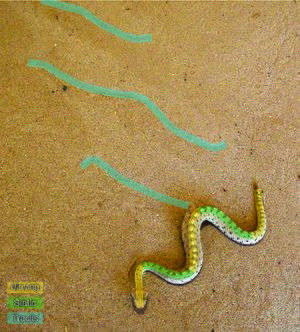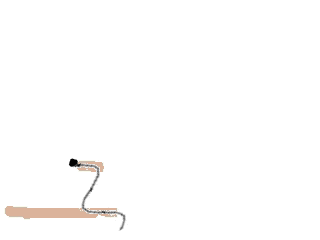Sidewinding


Sidewinding is a type of locomotion unique to caenophidian snakes, used to move across loose or slippery substrates. It is most often used by the Saharan horned viper, Cerastes cerastes, and the sidewinder rattlesnake, Crotalus cerastes, to move across loose desert sands, but it is also used by Homalopsine snakes in Southeast Asia to move across tidal mud flats. Any number of caenophidian snakes can be induced to sidewind on artificial smooth surfaces, though difficulty in getting them to do so and their proficiency at it vary greatly.
The method of movement is derived from lateral undulation, and is very similar, in spite of appearances. A picture of a snake performing lateral undulation would show something like a sine wave, with straight segments of the body having either a positive or negative slope. Sidewinding is accomplished by simply lifting all the segments with the same slope off the ground.
In the resultant movement, the snake's body is always in static (as opposed to sliding) contact when touching the ground. The head seems to be "thrown" forward, and the body follows, being lifted from the prior position and moved forward to lie on the ground ahead of where it was originally. Meanwhile, the head is being thrown forward again. In this way, the snake slowly progresses at an angle, leaving a series of mostly straight, J-shaped tracks. Because the snake's body is in static contact with the ground, without slip, imprints of the belly scales can be seen in the tracks, and each track is almost exactly as long as the snake.
Sidewinder rattlesnakes (Crotalus cerastes) can use sidewinding to ascend sandy slopes by increasing the portion of the body in contact with the sand to match the reduced yielding force of the inclined sand, allowing them to ascend up to the maximum possible sand slope without slip. Implementing this control scheme in a Snakebot capable of sidewinding allowed the robot to replicate the success of the snakes.[1]
Below is a crude animated line-drawing showing the locomotor pattern of sidewinding. The light brown areas are the tracks left behind, and also indicate where the body of the snake touched the ground.

One can determine the line of movement by drawing a line connecting either the right or left tips of the tracks.
References
- ↑ Marvi, H.; Gong, C.; Gravish, N.; Astley, H.; Travers, M.; Hatton, R. L.; Mendelson, J. R.; Choset, H.; Hu, D. L.; Goldman, D. I. (2014). "Sidewinding with minimal slip: Snake and robot ascent of sandy slopes". Science. 346 (6206): 224–229. doi:10.1126/science.1255718.